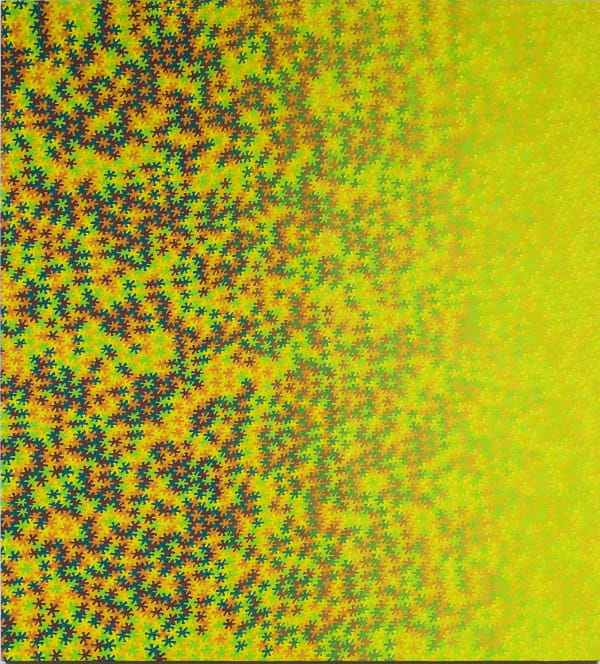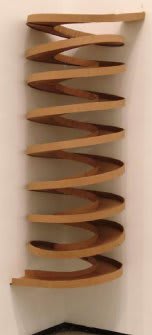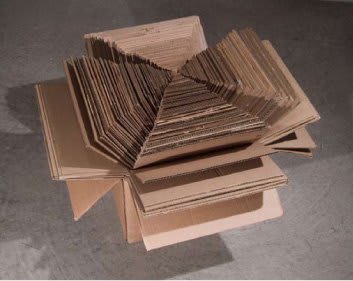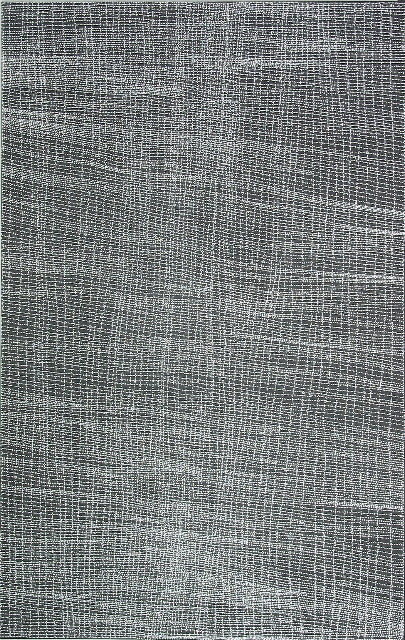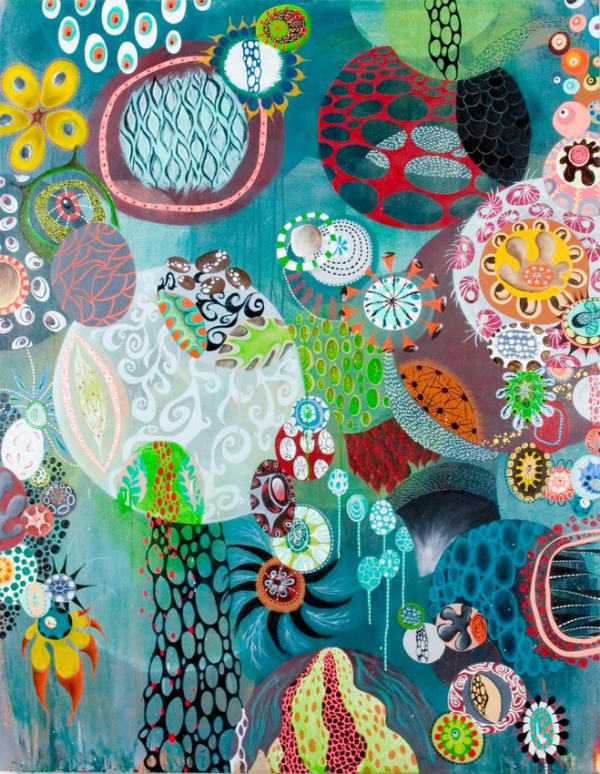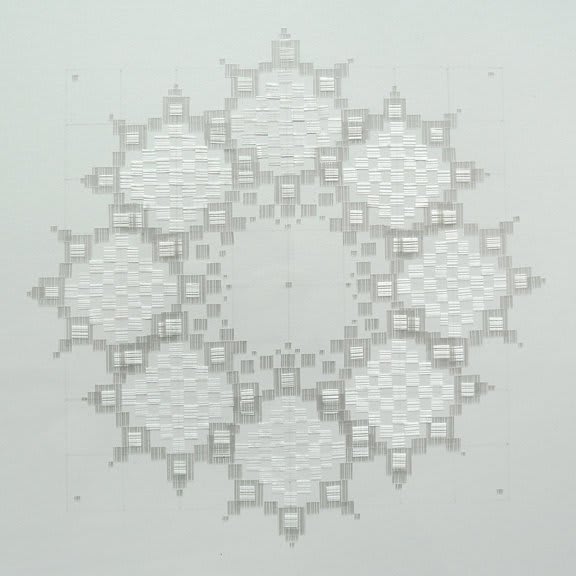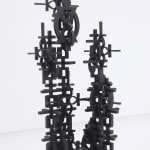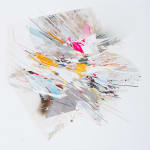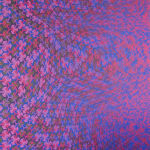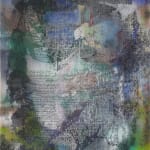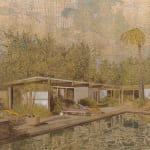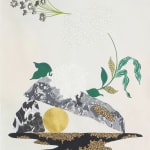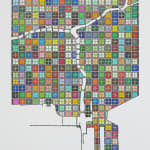New York Gallery
The “Pattern and Decoration” movement of the 1970s arose in response to the emergence of Minimalism and its strictures. It derived in part from Pop Art’s exuberant cultural mining and partly from feminist theorists’ re-thinking of traditional hierarchies. It expressed a renewed interest in “craft” and a sense that the inviolate distinction between the “fine arts” and “decorative arts” was artificial. Motifs from textiles, architecture and ceramics were appropriated and applied to painting according to the aesthetics of 20th Century formalism. Although the “P&D” movement was dismissed by many as “light weight,” its influence can be seen more and more in contemporary work. This exhibition explores the use of pattern as a tool for expression by a new generation of artists.
Anoka Faruqee’s paintings allude to a numerical language common to computer technology, weaving and Islamic tiling. Her works, which appear to be pixilated, examine painting’s relationship to mass production and the societal value placed on “originality.”
Andrea Higgins’ ” Pat” is a painted representation of a swatch of fabric from the dress First Lady Pat Nixon wore to her daughter’s wedding. For Higgins, the wardrobe one chooses is a reflection of personality as well as the social class to which one belongs or aspires to attain. She postulates that the style of the wife of a U.S. President also reflects the social climate and political priorities of the administration of which she is a part.
Julie Chang’s preoccupation with ornament is also based on her belief that patterns serve as markers of social class. For her, repetitive, wallpaper-like pattern can signify cultural anxieties, and camouflage private histories.
In Stefan Kurten’s paintings, the decorative patterns of vintage wallpaper intertwine with scenes of human habitation. Architecture can only, and sometimes barely, be viewed though a screen of history.
The landscapes of Jutta Haeckel’s paintings are criss-crossed by shadows, graffiti, and tattoo-like markings which filter our “view.” Inspection reveals these “marks” to be in fact the ground of the painting and the landscape to have been painted in around them, subverting notions of content and surface.
Driss Ouadahi’s paintings are riffs on the modernist grid painting, as well as representations of the high-rise housing developments built on the peripheries of cities like Paris and Berlin to accommodate growing immigrant populations.These abstract paintings bring to mind the politics of class, religion, ethnicity and ghettoization.
Without a straight edge, Nicole Phungrasamee Fein lays down bands of color on paper. Each stroke is the product of a cycle of inhalation, breath retention and mark making, then exhalation. Through a process that owes as much to performance-based body art or meditation practices as it does traditional water-color painting, she creates luminous fields of pattern.
Elise Adibi’s paintings are each constructed from an algorithm. Self-generating, they develop systematically, yet erratically. Patterns loop back on themselves and the clarity of the original pattern becomes corrupted by the “noise” of physicality, error and complexity.
Gerhard Mayer’s wall drawings are abstract expressions of quantum physics’ interpretations of the non-material aspects of matter. They are drawn with India ink, scanned, then e-mailed from his studio in Germany to a production facility in the U.S. Here they are manufactured in vinyl with adhesive backing for mounting directly to a wall.
Other artists included in the exhibition are Jonathan Brand, Reed Danziger, Susan Marie Dopp, Jacob el Hanani, Joan Grubin, Melinda Hackett, Marietta Hoferer, Dorothy Napangardi, Gay Outlaw, Lordy Rodriguez, Brian Wasson, Crystal Liu & Jeremy Stenger.
-

-
 Nicole Phungrasamee FeinUntitled (2060307), 2007watercolor on paper17 5/8 x 17 5/8 inches/44.8 x 44.8 cm
Nicole Phungrasamee FeinUntitled (2060307), 2007watercolor on paper17 5/8 x 17 5/8 inches/44.8 x 44.8 cm -
 Nicole Phungrasamee FeinUntitled (2052007), 2007watercolor on paper17.626 x 17.625 inches paper
Nicole Phungrasamee FeinUntitled (2052007), 2007watercolor on paper17.626 x 17.625 inches paper
11 5/8 x 11 5/8 image -

-
 Susan Marie DoppUntitled 29 (dbl gr), 2003gouache and graphite on mulberry paper17.5 x 18.5 inches
Susan Marie DoppUntitled 29 (dbl gr), 2003gouache and graphite on mulberry paper17.5 x 18.5 inches
44.45 x 46.99 cms -
 Jutta HaeckelStreiflicht, 2007oil on canvas59 1/8 x 47 1/4 inches/150.1 x 120.1 cm
Jutta HaeckelStreiflicht, 2007oil on canvas59 1/8 x 47 1/4 inches/150.1 x 120.1 cm -
 Driss OuadahiOld and New Quarter, 2007oil on canvas35.46 x 39.4 inches
Driss OuadahiOld and New Quarter, 2007oil on canvas35.46 x 39.4 inches
90 x 100 cms -
 Driss OuadahiExtension, 2007oil on canvas35.46 x 39.4 inches
Driss OuadahiExtension, 2007oil on canvas35.46 x 39.4 inches
90 x 100 cms -

-

-
 Adibi, EliseRPGB/GBPR II, 2007oil on linen30 x 30 inches
Adibi, EliseRPGB/GBPR II, 2007oil on linen30 x 30 inches
76.2 x 76.2 cms -

-

-

-

-
 Lordy RodriguezShifted Lakes (Geological Series), June 2005ink on paper32 x 46 inches
Lordy RodriguezShifted Lakes (Geological Series), June 2005ink on paper32 x 46 inches
81.28 x 116.84 cms -
 Lordy RodriguezRippled Hills (Geological Series), June 2005ink on paper32 x 46 inches
Lordy RodriguezRippled Hills (Geological Series), June 2005ink on paper32 x 46 inches
81.28 x 116.84 cms -
 Lordy RodriguezBarchan Dunes, 2006ink on paper32 x 46 inches
Lordy RodriguezBarchan Dunes, 2006ink on paper32 x 46 inches
81.3 x 116.8 cms -

-
 Hackett, MelindaDitchwitch, 2006oil on canvas54 x 42 inches
Hackett, MelindaDitchwitch, 2006oil on canvas54 x 42 inches
137.2 x 106.7 cms -

-

-

-

-

-

-

-

-

-

-

-

-

-

-
 Julie W. ChangDesign for the Well-Lived Life: Pushcart Dad Head, 2007inkjet and silkscreen on paperheight variable x 17 inches
Julie W. ChangDesign for the Well-Lived Life: Pushcart Dad Head, 2007inkjet and silkscreen on paperheight variable x 17 inches -

-

-

-
 Julie W. ChangLower Floor, 2007acrylic on panel12 x 16 inches
Julie W. ChangLower Floor, 2007acrylic on panel12 x 16 inches
30.5 x 40.6 cms -

-


